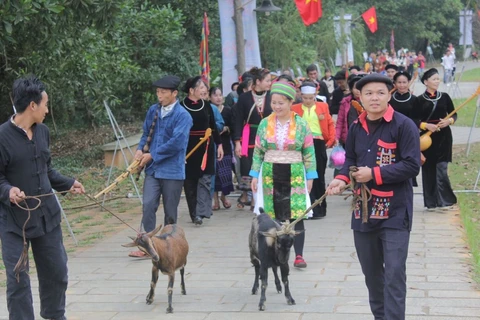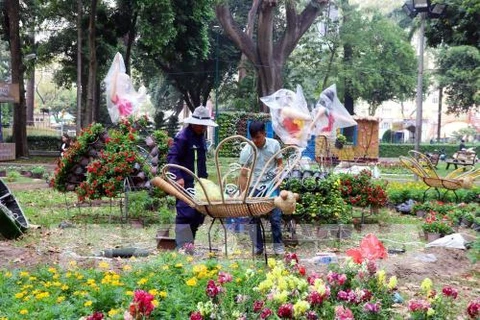 “Lay co" folk game is played at Mau Son Tourism Festival in Lang Son in 2019. (Photo: langson.gov.vn)
“Lay co" folk game is played at Mau Son Tourism Festival in Lang Son in 2019. (Photo: langson.gov.vn) Hanoi (VNA) – Together with sli and luon singing, “lay co” folk game has been indispensable at any gathering, especially during the Lunar New Year (Tet) holiday, of the Tay and Nung ethnic groups in Lang Son and many other provinces. Actually, the organisation of the game creates a jubilant atmosphere while helping preserve traditional values.
“Lay co”, also called “sai ma”, is similar to the “rock – paper – scissor” game of Kinh people. However, it is a little bit more complicated as it requires a combination of mouth, hands and brain. In the game, two people sit face-to-face with each other and the winner will compete with the other person while the loser will be fined by drinking wine.
“Lay co” helps players nurture their patience, and challenges their agility.
According to Vi Hong Nhan, head of the provincial association for traditional folk songs preservation and a researcher of Tay and Nung traditional culture, Tay and Nung ethnic minority groups have a wide range of traditional games such as nem con (con throwing), danh yen (similar to badminton), and day gay (stick pushing), among others. Of which, “lay co” is a unique game that shows off the players’ talent.
Along with other intangible heritages, “lay co” has made contributions to diversifying the cultures of Tay and Nung ethnic people.
Nhan said that precise judgment is important in the game. Players can spread out as many fingers as they like, as long as the number they shout fits with the total fingers of the two. Whoever guesses correctly will win the game.
The judgment is made in Tay and Nung languages such as “nhat” is number 1, “nhi” is number 2, “slam” is number 3… If the players have the same result, they should say “thong sinh ma”.
“Lay co” is for men only, women barely play it as players have to drink liquor while playing, said Hoang Van Thanh, a Tay ethnic minority man from Dai Dong commune, Trang Dinh district. “The game makes me really happy as it brings everybody in the village closer to each other. I want it to be perserved for the future generations so it will not be forgetten,” he said.
Last year, major cultural events in the province, such as the Lang Son Culture, Sports and Tourism Week and the third Chi Lang Custard Apple Festival, featured “lay co” as part of the folk game programme. Spring festivals in some districts also organised the game, for example, Bung Kham Festival in Trang Dinh district and Hai Yen Festival in Cao Loc district. Mau Son tourism festival in Loc Binh district held “lay co” for two years in a row, 2018 and 2019, which was warmly welcomed by people from various ethnic minority communities such as Tay, Nung and Dao. The game seemed to create a special bond between players, making strangers become friends.
“In the coming time, we will conduct a scientific study to explore values of the game and then develop a plan for better preserving and promoting it,” said Director of the provincial Department of Culture, Sports and Tourism Nguyen Phuc Ha. “Additionally, we are encouraging people to continue preserving the original version of the folk game and practicing it frequently so it will not fade away.”
A new year has arrived, traditional toasts and witty sounds of people playing “lay co” cannot be absent in every feast of Tay and Nung people. Modern games are becoming more and more popular in today’s society but “lay co” is still largely played by Tay and Nung ethnic villagers across Lang Son.
Traditional culture is a spiritual foundation of each nation, region and people so the preservation and promotion of traditional customs and practices like “lay co” is important to the province and Vietnam at large./.
VNA























